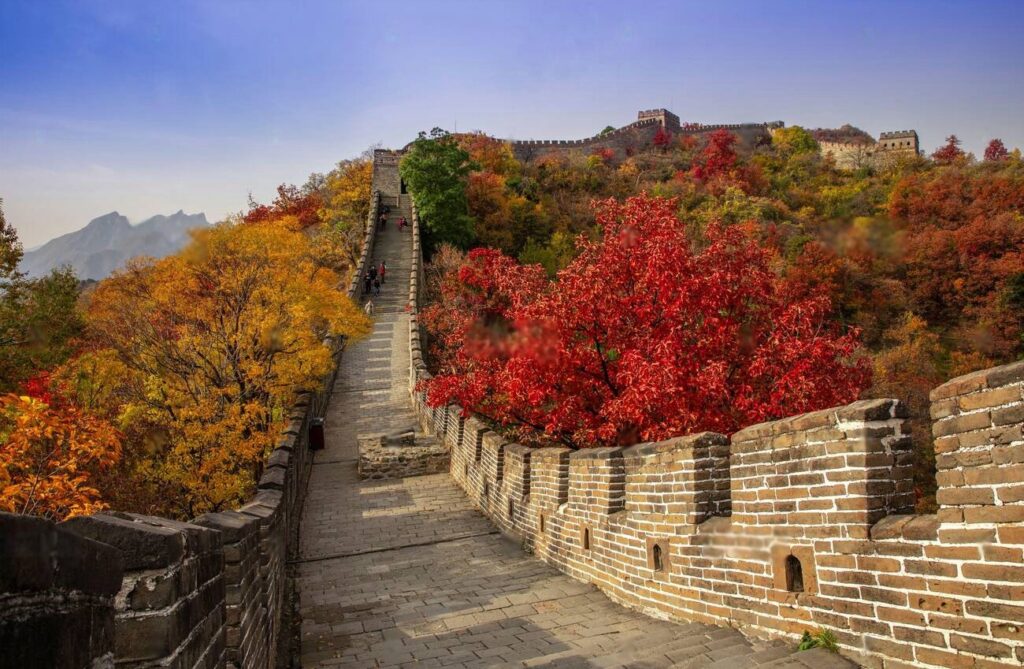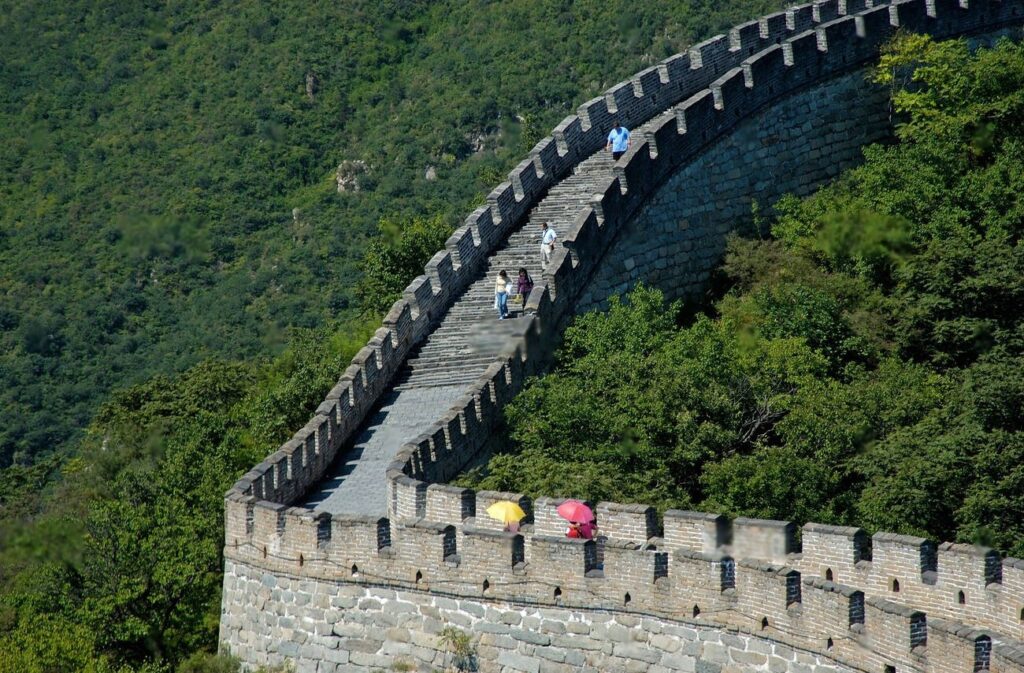The Great Wall of China is one of the most amazing things ever built by humans. It stretches across northern China and has amazed people from around the world for hundreds of years. The Great Wall is not just a wall, it shows what people can do when they work together over many years. In this blog, we’ll explore why the Great Wall is such an incredible achievement.
Table of Contents
A Brief History of the Great Wall
The Great Wall wasn’t built all at once. It was made over more than 2,000 years by different Chinese rulers. The first walls were built around 700 BCE, when separate Chinese states made walls to protect themselves from enemies.
The first emperor of China, Qin Shi Huang, connected many of these walls around 221 BCE to create what became known as the Great Wall. Later, during the Han Dynasty (206 BCE-220 CE), the wall was made longer to protect important trade routes.

After many years of little building, the wall got major upgrades during the Ming Dynasty (1368-1644 CE). The Ming emperors replaced old dirt walls with stronger brick and stone. Most of the wall that tourists visit today was built during this time.
What’s really interesting about the Great Wall is how it shows China’s changing relationships with its neighbors. When China was strong or had good relations with northern peoples, they built less. When they felt threatened, they built more.
After the Ming Dynasty fell to the Qing Dynasty in 1644, the wall became less important for defense and started to fall apart. It wasn’t until the 1900s that people began working to save and restore this amazing structure.
Why the Great Wall Was Built
The main reason for building the Great Wall was protection. Throughout Chinese history, farming communities faced threats from horse-riding nomads from the north. These nomads, like the Mongols, could attack Chinese villages very quickly.
The wall was never meant to be impossible to cross. Instead, it was part of a smart defense system that:
- Helped the military: The wall gave Chinese soldiers high ground to fight from. Watchtowers stored weapons and supplies.
- Controlled borders: The wall forced travelers and traders to use certain gates where taxes could be collected.
- Sent messages: Using smoke signals by day and fire by night, warnings about enemies could be sent quickly along the wall.
- Looked impressive: The massive wall showed China’s power and might have scared off smaller groups of raiders.
- Kept people in: Sometimes the wall also stopped Chinese farmers from leaving.
The wall also had deep meaning for Chinese people. It showed where “civilization” ended and the “outside world” began. It showed that the emperor was serious about protecting his people.
Despite its size, the Great Wall didn’t always work perfectly. Major invasions sometimes got through or went around the wall. The Mongols conquered China despite the wall, and ironically, the last dynasty of imperial China (the Qing) was started by people from beyond the wall.
Must-Visit Sections of the Great Wall
While the Great Wall is thousands of miles long, some parts are better for visitors than others. Each section offers something special.
Badaling: About 43 miles from Beijing, this is the most popular section. It’s been fixed up and has modern facilities. It’s easy to reach and good for first-time visitors, but it can get very crowded.
Mutianyu: About 43 miles from Beijing, Mutianyu is less crowded than Badaling but still easy to visit. It has 22 watchtowers and beautiful forest views. Visitors can use a cable car to go up and down, or try a fun toboggan ride down. The wall here follows mountain ridges, making for great photos.

Jinshanling: About 80 miles from Beijing, Jinshanling has both restored and original sections. This gives visitors a chance to see both how the wall was built and how it might have looked when new. It’s popular with hikers who often walk the 6 miles to Simatai.
Simatai: This section has steep drops and beautiful mountain views. It keeps much of its original character while being partly restored. Visitors can take a night tour to see the wall lit up under the stars.
Huanghuacheng: Known as the “Yellow Flower Wall” because of wildflowers that bloom in summer, part of this section is underwater in a reservoir. It gets fewer visitors, so it’s more peaceful.
Jiankou: For adventure lovers, this unrestored “wild wall” offers a real challenge. Built on steep ridges, it has amazing views but requires good fitness. The “Nine-Eye Tower” lets you see multiple sections of the wall.
Shanhaiguan: Called the “First Pass Under Heaven,” this marks the eastern end of the Great Wall where it meets the sea. It has impressive defensive buildings.
Jiayuguan: At the western end of the Ming Dynasty wall, Jiayuguan sits in the desert. The fortress here once marked the edge of Chinese civilization. The desert landscape is very different from the mountains in the east.
To really understand the wall, try to visit more than one section to see how it changes across different landscapes.
How Long is the Great Wall of China?
The Great Wall is much longer than most people think. For many years, people said it was about 3,700 miles long. But in 2012, after careful study, Chinese experts announced that just the Ming Dynasty walls are 5,500 miles long. When including walls from all time periods, the total length is an amazing 13,171 miles!

This is even more impressive when you think about the different types of land the wall crosses. From mountains near Beijing to western deserts, builders had to adapt to local conditions. In the mountains, they built along ridges for better defense. In flatter areas, they made wider walls often with ditches in front.
The wall’s size varies a lot:
- Height: Usually 16-26 feet, but ranging from 6.5-46 feet
- Width at bottom: 13-16 feet on average
- Width at top: 10-13 feet, wide enough for five horses or ten soldiers to walk side by side
Beyond the main wall, the whole defense system included thousands of watchtowers, signal towers, and forts. During the Ming Dynasty, over one million soldiers were stationed along the wall.
The wall was never actually one continuous line. Natural barriers like mountains and rivers were used as part of the system, and in some places, multiple walls were built for deeper defense.
The Best Times to Visit China’s Destinations
When you should visit the Great Wall depends on what’s most important to you weather, crowds, or scenery.
Spring (April-May): Spring has mild weather and blooming plants, making it great for photos. The mountains around the wall become colorful as flowers bloom and trees grow new leaves. There’s some rain, but clear days offer great views. Tourist numbers start to increase but are still manageable except during Chinese holidays.
Summer (June-August): Summer is the busiest time, with big crowds at popular sections like Badaling and Mutianyu. The green mountains look beautiful, but summers in northern China can be hot and humid, sometimes over 86°F. Afternoon thunderstorms are common, so morning visits are best. Summer does have more daylight hours for exploring.
Autumn (September-October): Many think autumn is the best season to visit. Temperatures are comfortable, there’s little rain, and the air is clearer for photos. The forests turn red, orange, and gold, creating a beautiful contrast with the gray wall. Chinese National Day (October 1) brings a week-long holiday with lots of Chinese tourists, so plan carefully.

Winter (November-March): Winter offers a unique experience of the wall. Far fewer tourists visit, giving you a more peaceful experience. After snowfall, the wall and mountains become a winter wonderland, creating stunning photo opportunities. However, it can be very cold, and some sections (or cable cars) may close in bad weather. Mutianyu is usually well-maintained during winter.
For photographers:
- Early morning has the best light and fewer crowds
- Days after rain often have the clearest views
- Full moon nights at sections with evening access create magical experiences
Try to avoid Chinese public holidays when domestic tourism peaks. Chinese New Year and National Day (October 1-7) are especially busy.
Fun Facts About the Great Wall
The Great Wall has many interesting stories and surprising facts:
Not Visible from Space: Despite what many people believe, the Great Wall cannot be seen with the naked eye from space or even from low Earth orbit. Chinese astronaut Yang Liwei confirmed this after his 2003 mission. It can be seen from lower orbits with help from telescopes or cameras.
The Sticky Rice Secret: During the Ming Dynasty, builders added sticky rice soup to their mortar. Scientists have found that this actually made the walls stronger and helped them last longer. This ancient recipe was one of the world’s first composite building materials.
The Human Cost: While estimates vary, historians think hundreds of thousands of workers died during the wall’s construction across various dynasties. Many were soldiers, prisoners, or farmers forced to work. According to legend, a woman named Meng Jiangnu cried so hard when she learned of her husband’s death during construction that her tears collapsed part of the wall, revealing his bones.
The Wall’s Disappearing Act: Despite its massive size, about 30% of the Ming Dynasty wall has disappeared due to erosion, human damage, and people taking bricks to use for other buildings. Serious conservation efforts only began in the late 1900s.
Not Just One Wall: What we call the “Great Wall” is actually a network of walls, ditches, and natural barriers built by different dynasties, sometimes with multiple lines of defense.
World’s Largest Cemetery: Some historians call the Great Wall the world’s largest cemetery because workers who died during construction were often buried within the wall itself. Archaeological studies have confirmed human remains in parts of the wall.
The Monster That Helped Build the Wall: According to Chinese mythology, a monster called Nian (年) was afraid of loud noises and the color red. Defenses created against this creature supposedly inspired some features of the wall. This legend is now associated with Chinese New Year celebrations.
Record-Breaking Tourism: Badaling set a world record for the most visited section of the Great Wall, with over 10 million visitors yearly before COVID-19.
Graffiti Through the Ages: Carved messages on the wall date back centuries, with some Ming Dynasty soldiers leaving their names and service dates. Modern graffiti has become a serious conservation problem.
The Star Connection: Some watchtowers were designed to help soldiers track time and seasons using the positions of stars and planets.
These fascinating details remind us that beyond its impressive physical presence, the Great Wall represents thousands of years of human stories.
Exploring the Great Wall Today
Today’s visitors to the Great Wall enjoy experiences very different from its original military purpose. The ancient wall now offers many ways to explore, have adventures, and learn about Chinese culture.
Tourist Facilities: The most popular sections of the wall have good visitor facilities. Badaling and Mutianyu have cable cars, visitor centers, restaurants, and souvenir shops. More remote sections offer a more authentic but less comfortable experience. Many tourists combine their wall visit with nearby attractions like the Ming Tombs.

Adventure Activities: Beyond regular sightseeing, adventure lovers can:
- Hike between different sections (the Jinshanling to Simatai trek is especially popular)
- Camp near certain unrestored sections (with proper permits)
- Join marathon races held yearly on parts of the wall
- Try paragliding near certain sections for aerial views
- Take night tours at lit-up sections like Simatai
Photography: The wall is perfect for photographers, with its winding path across dramatic landscapes offering endless photo opportunities. Special photography tours focus on sunrise, sunset, or seasonal highlights like autumn colors or winter snow.
Conservation Volunteering: Several organizations let visitors help with Great Wall conservation, from cleanup to helping with restoration projects.
Virtual Exploration: For those who can’t visit in person, technology now offers alternatives. Virtual reality tours, high-quality photos, and 3D models allow remote exploration of the wall’s most spectacular sections.
Practical tips for visitors:
- Plan at least half a day for any section, or a full day to avoid rushing
- Wear comfortable shoes with good grip; some sections have steep, uneven steps
- Bring water, sun protection, and proper clothing for the weather
- Consider hiring a guide to learn more about the history
- Visit on weekdays if possible to avoid weekend crowds
While it’s easy to visit the most popular sections on your own, more remote or wild sections may require guides or permission. As conservation becomes more important, some previously open sections now have visitor limits, so research before you go.
The Great Wall’s Impact on Chinese Culture
The Great Wall is much more than just a physical structure, it holds a central place in Chinese identity. Over centuries, it has become a powerful national symbol in art, literature, philosophy, and politics.
In Literature and Art
Since at least the Tang Dynasty (618-907 CE), Chinese poets have written about the wall, often using it to represent separation, endurance, or the border between civilization and wilderness. Famous poems like Wang Zhihuan “At Heron Tower” mention the wall when talking about border regions. In painting, the wall often appears in traditional landscape art, showing human achievement in harmony with nature.
Philosophical Meaning
The wall represents traditional Chinese ideas about boundaries between order and chaos, civilization and barbarism, the known and unknown. Confucian texts often mention the wall when discussing proper governance and defense, while Daoist perspectives sometimes see it as showing humanity’s tendency to separate rather than flow with nature.
Modern National Identity
After China’s difficult experiences with Western powers in the 1800s, the Great Wall gained new importance as a symbol of resistance against foreign invasion. During the 1900s, especially after the founding of the People’s Republic of China in 1949, the wall became a primary symbol of Chinese civilization’s age, cleverness, and continuity. Chairman Mao Zedong’s famous quote, “He who has not climbed the Great Wall is not a true man,” made it an important patriotic site.

Popular Culture
The wall appears throughout modern Chinese pop culture in movies, TV shows, video games, and advertising. International recognition has further increased its status, with its designation as a UNESCO World Heritage Site in 1987 and its selection as one of the New Seven Wonders of the World in 2007 becoming sources of national pride.
Economic Impact
Beyond cultural importance, the wall drives major economic activity. It remains China’s top tourist attraction, generating billions in revenue and supporting countless jobs in tourism, hospitality, and related industries. Images of the wall sell everything from luxury goods to everyday products, both in China and internationally.
Educational Role
For generations of Chinese schoolchildren, the Great Wall serves as a hands-on history lesson a physical connection to their ancestors and traditional values like perseverance, teamwork, and national defense. School textbooks highlight the wall as evidence of China’s historical technological skill and organizational ability.
The wall’s cultural impact extends far beyond China as well. Internationally, it often represents Chinese civilization itself, an instantly recognizable symbol that stands for China in global contexts from Olympic ceremonies to international diplomacy.
Tips for Hiking the Great Wall
For travelers wanting a deeper connection with the Great Wall, hiking offers an amazing experience. Unlike short visits to restored tourist sections, longer hikes show how the wall fits into the landscape and give glimpses of its authentic historical character. Here are important tips for a good hiking adventure:
Choosing Your Route:
- For Beginners: The restored section from Jinshanling to Simatai West (about 3.4 miles) is moderately difficult with great views. Parts are restored while others remain authentic.
- Intermediate Challenge: The Gubeikou to Jinshanling route (about 6.2 miles) covers both restored and wild walls with moderate hills.
- Advanced Adventure: The Jiankou section offers challenging terrain for experienced hikers, with steep climbs and crumbling paths but spectacular photo opportunities.
How to Prepare:
- Get in Shape: Even restored sections have steep steps and uneven surfaces. Regular cardio exercise and stair-climbing before your trip will help you enjoy it more.
- Footwear: Strong hiking boots with ankle support and good grip are essential, especially on unrestored sections.
- Weather Planning: Check forecasts carefully. Spring and fall offer ideal hiking conditions, but prepare for temperature changes. Summer hikes should start early to avoid midday heat, while winter requires proper cold-weather gear.
- Navigation: While major hiking routes are increasingly well-marked, bring a paper map, compass, and GPS device or smartphone with offline maps. Cell service can be unreliable in mountainous areas.
What to Pack:
- Lightweight backpack with water system or water bottles (at least 2 liters per person)
- Energy-rich snacks and lunch (food options are limited or non-existent on most routes)
- First aid kit including blister treatment
- Sun protection (hat, sunscreen, sunglasses)
- Walking poles to reduce strain on knees during downhill sections
- Camera with extra batteries
- Wet wipes and hand sanitizer (toilet facilities are rare)
- Cash for entrance fees and transportation (credit cards may not be accepted in remote areas)
Planning Details:
- Guide or No Guide: While experienced hikers can do certain routes on their own, a knowledgeable guide improves safety and historical understanding, especially on unrestored sections.
- Transportation: Arrange return transportation in advance. Some sections have limited public transport options, especially for return journeys in the late afternoon.
- Permits: Some unrestored sections technically require permits or may be officially closed to hikers. Local guides can usually help navigate these restrictions.
- Camping: Overnight camping on the wall itself is generally not allowed, though some tour operators offer legal camping experiences near certain sections.
Responsible Hiking Practices:
- Take all trash with you
- Stay on established paths to prevent further damage to this historical structure
- Never take bricks, stones, or artifacts as souvenirs
- Respect any local restrictions or closure signs
- Consider donating to legitimate Great Wall conservation efforts
For those wanting a truly immersive experience, multi-day hiking trips can connect several sections of the wall. These longer journeys, typically organized by specialized tour companies, often include stays in nearby villages, providing cultural insights alongside the historical exploration.
Why the Great Wall is a UNESCO World Heritage Site
In 1987, UNESCO added the Great Wall of China to the World Heritage List, recognizing its “outstanding universal value” to humanity. This important designation acknowledges the wall’s significance according to several specific criteria.

Criterion (i): The Great Wall represents a masterpiece of human creative genius. Its construction required clever engineering solutions to overcome diverse geographical challenges. The wall’s builders developed sophisticated techniques for foundations, drainage, and structure that allowed their creation to last for centuries.
Criterion (ii): The Great Wall shows an important exchange of human values over time. It demonstrates the evolution of military architecture across multiple Chinese dynasties, incorporating techniques from various regions and cultures.
Criterion (iii): The wall provides exceptional evidence of imperial Chinese civilization. It represents the high point of the ancient Chinese tradition of wall-building for defense and marking territory.
Criterion (iv): The Great Wall is an outstanding example of a type of building and landscape that shows important stages in human history. It embodies the military, political, and strategic aspects of China’s historical relationship with nomadic peoples over more than 2,000 years.
Criterion (vi): The wall is directly associated with events and living traditions of great significance. It symbolizes the unification of China and has inspired countless artistic and cultural expressions throughout Chinese history.
The UNESCO designation covers sections of the Great Wall built during various dynasties from the 3rd century BCE to the 17th century CE, including all fortifications, passes, and related structures. This approach recognizes that the wall’s value lies not just in its most impressive restored sections but in the entire historical defense system it represents.
World Heritage status brings both benefits and responsibilities. It has raised international awareness of the wall’s historical importance and helped secure funding for conservation. However, it also requires China to protect and properly manage this irreplaceable cultural treasure according to international standards.
Conservation challenges remain big. Natural erosion, extreme weather, and human activities (from tourism to theft of materials) continue to threaten many sections. Chinese authorities have implemented strict preservation laws, limiting development near the wall and establishing buffer zones around protected sections. Modern conservation techniques, including 3D scanning and special mortar formulas that match original materials, are being used to maintain authentic restorations.
The Great Wall’s UNESCO status highlights an important truth: while the wall stands within China’s borders, its cultural significance goes beyond national boundaries. As one of humanity’s most ambitious building projects, it belongs to the world’s shared heritage and deserves global cooperation for its preservation.
The Great Wall of China stands as a monument not just to military defense but to human determination, cultural continuity, and clever building. From its beginnings as simple earth walls to the magnificent stone and brick structure we recognize today, the wall represents one of humanity’s most ambitious building projects.
What makes the Great Wall truly special is not just its huge size but its symbolic power. It has changed from a practical military installation into a cultural icon that represents Chinese civilization itself. For today’s visitors, whether hiking along its weathered paths or enjoying panoramic views from its watchtowers, the wall offers a physical connection to thousands of years of history.
As we face an uncertain future, the Great Wall reminds us of human resilience and adaptability. It has survived invasions, earthquakes, extreme weather, and centuries of neglect, yet still stands as proof of what humans can achieve through working together and determination. In our increasingly connected world, perhaps the most valuable lesson the Great Wall offers is not about division and defense, but about the lasting impact of human ingenuity and our ability to create works that stand the test of time.












